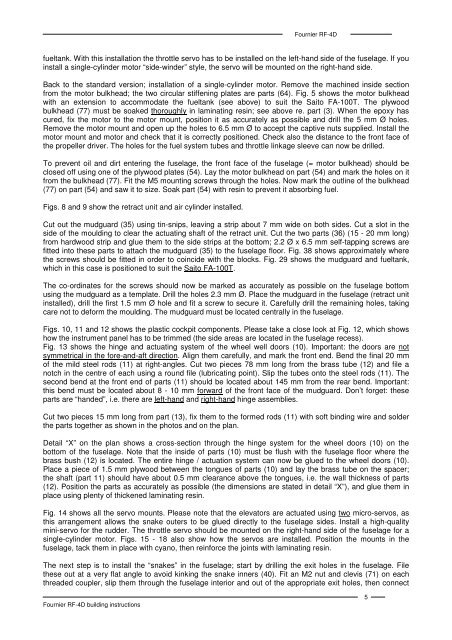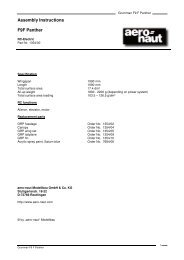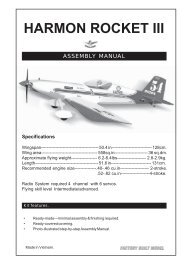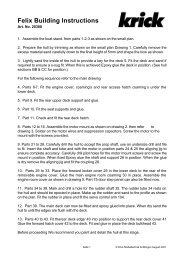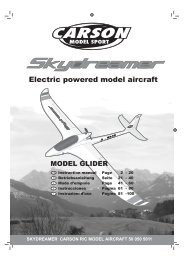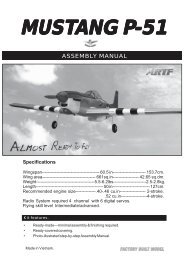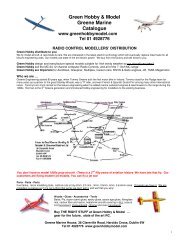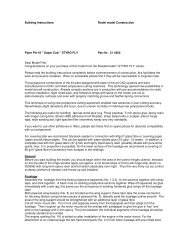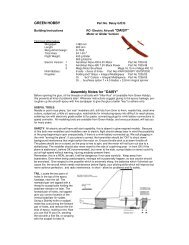Building instructions Fournier RF-4D - Aero-naut
Building instructions Fournier RF-4D - Aero-naut
Building instructions Fournier RF-4D - Aero-naut
You also want an ePaper? Increase the reach of your titles
YUMPU automatically turns print PDFs into web optimized ePapers that Google loves.
<strong>Fournier</strong> <strong>RF</strong>-<strong>4D</strong>fueltank. With this installation the throttle servo has to be installed on the left-hand side of the fuselage. If youinstall a single-cylinder motor “side-winder” style, the servo will be mounted on the right-hand side.Back to the standard version; installation of a single-cylinder motor. Remove the machined inside sectionfrom the motor bulkhead; the two circular stiffening plates are parts (64). Fig. 5 shows the motor bulkheadwith an extension to accommodate the fueltank (see above) to suit the Saito FA-100T. The plywoodbulkhead (77) must be soaked thoroughly in laminating resin; see above re. part (3). When the epoxy hascured, fix the motor to the motor mount, position it as accurately as possible and drill the 5 mm Ø holes.Remove the motor mount and open up the holes to 6.5 mm Ø to accept the captive nuts supplied. Install themotor mount and motor and check that it is correctly positioned. Check also the distance to the front face ofthe propeller driver. The holes for the fuel system tubes and throttle linkage sleeve can now be drilled.To prevent oil and dirt entering the fuselage, the front face of the fuselage (= motor bulkhead) should beclosed off using one of the plywood plates (54). Lay the motor bulkhead on part (54) and mark the holes on itfrom the bulkhead (77). Fit the M5 mounting screws through the holes. Now mark the outline of the bulkhead(77) on part (54) and saw it to size. Soak part (54) with resin to prevent it absorbing fuel.Figs. 8 and 9 show the retract unit and air cylinder installed.Cut out the mudguard (35) using tin-snips, leaving a strip about 7 mm wide on both sides. Cut a slot in theside of the moulding to clear the actuating shaft of the retract unit. Cut the two parts (36) (15 - 20 mm long)from hardwood strip and glue them to the side strips at the bottom; 2.2 Ø x 6.5 mm self-tapping screws arefitted into these parts to attach the mudguard (35) to the fuselage floor. Fig. 38 shows approximately wherethe screws should be fitted in order to coincide with the blocks. Fig. 29 shows the mudguard and fueltank,which in this case is positioned to suit the Saito FA-100T.The co-ordinates for the screws should now be marked as accurately as possible on the fuselage bottomusing the mudguard as a template. Drill the holes 2.3 mm Ø. Place the mudguard in the fuselage (retract unitinstalled), drill the first 1.5 mm Ø hole and fit a screw to secure it. Carefully drill the remaining holes, takingcare not to deform the moulding. The mudguard must be located centrally in the fuselage.Figs. 10, 11 and 12 shows the plastic cockpit components. Please take a close look at Fig. 12, which showshow the instrument panel has to be trimmed (the side areas are located in the fuselage recess).Fig. 13 shows the hinge and actuating system of the wheel well doors (10). Important: the doors are notsymmetrical in the fore-and-aft direction. Align them carefully, and mark the front end. Bend the final 20 mmof the mild steel rods (11) at right-angles. Cut two pieces 78 mm long from the brass tube (12) and file anotch in the centre of each using a round file (lubricating point). Slip the tubes onto the steel rods (11). Thesecond bend at the front end of parts (11) should be located about 145 mm from the rear bend. Important:this bend must be located about 8 - 10 mm forward of the front face of the mudguard. Don’t forget: theseparts are “handed”, i.e. there are left-hand and right-hand hinge assemblies.Cut two pieces 15 mm long from part (13), fix them to the formed rods (11) with soft binding wire and solderthe parts together as shown in the photos and on the plan.Detail “X” on the plan shows a cross-section through the hinge system for the wheel doors (10) on thebottom of the fuselage. Note that the inside of parts (10) must be flush with the fuselage floor where thebrass bush (12) is located. The entire hinge / actuation system can now be glued to the wheel doors (10).Place a piece of 1.5 mm plywood between the tongues of parts (10) and lay the brass tube on the spacer;the shaft (part 11) should have about 0.5 mm clearance above the tongues, i.e. the wall thickness of parts(12). Position the parts as accurately as possible (the dimensions are stated in detail “X”), and glue them inplace using plenty of thickened laminating resin.Fig. 14 shows all the servo mounts. Please note that the elevators are actuated using two micro-servos, asthis arrangement allows the snake outers to be glued directly to the fuselage sides. Install a high-qualitymini-servo for the rudder. The throttle servo should be mounted on the right-hand side of the fuselage for asingle-cylinder motor. Figs. 15 - 18 also show how the servos are installed. Position the mounts in thefuselage, tack them in place with cyano, then reinforce the joints with laminating resin.The next step is to install the “snakes” in the fuselage; start by drilling the exit holes in the fuselage. Filethese out at a very flat angle to avoid kinking the snake inners (40). Fit an M2 nut and clevis (71) on eachthreaded coupler, slip them through the fuselage interior and out of the appropriate exit holes, then connect<strong>Fournier</strong> <strong>RF</strong>-<strong>4D</strong> building <strong>instructions</strong>5


